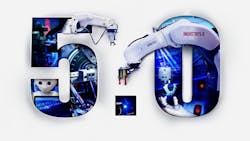Why workers are key to digital transformation and Industry 5.0
In their book Augmented Lean: A Human Centric Framework for Managing Frontline Operations, the authors take a deep dive into the current state of digital transformation in industry, what’s holding back the wide-spread upscaling of solutions, and what might be the key to unlocking the power of data for companies large and small.
Authors Nathan Linder, Ph.D., and Trond Arne Undheim, PhD., are pioneering entrepreneurs of industrial tech. Both have worked or studied at the Massachusetts Institute of Technology (MIT) and worked at other technology companies, including Samsung, Rethink Robotics, WPP and Oracle, to name a few. (Note: they are both involved with a frontline operations platform called Tulip. While this doesn’t discredit their vast research or opinions, it should be clear upfront they represent a no-code solution, which is entwined in their theories about how technology should evolve industry, and the book is largely a collection of case studies of Tulip customers.)
But if you don’t already know the winding and interconnected formation of many of today’s industrial software giants—the story of how industrial tech code from United Computing, founded in 1963, became Siemens PLM Software, purchased for $3.5 billion; or OSIsoft’s PI System, founded in 1980, was acquired by AVEVA (of which Schneider Electric owns a 60% stake) for $5 billion; or PTC, which launched industrial-scale 3D modeling in 1985, got a $1 billion equity investment from Rockwell Automation in 2018; or Wonderware, which reshaped automation in the 1990s with a major market share of the supervisory control and data acquisition (SCADA) industry, was sold to British-based Siebe plc in 1998, which merged with BTR plc to form Invensys, which merged with Schneider Electric in 2014 and is sold as AVEVA—it’s worth the read alone. I also enjoyed the deep dive into industrial revolution history and a look at how industrial engineering has changed over the decades.
But to the short point, what is no-code or low-code programming? How about a frontline operations platform? If those are terms you don’t know or want to learn more, this book is for you. Here I’ve highlighted a few key insights.
It’s a wrap on Industry 4.0
The book includes a sweeping history of Industrial Revolutions 1.0 to 6.0. “Industry 1.0 (eighteenth century) was the era of mechanization, Industry 2.0 (nineteenth century) was the era of mass production, Industry 3.0 was the era of automation (twentieth century), Industry 4.0 (late twentieth century) was the era of digitalization, and Industry 5.0 (twenty-first century) begins with the era of intensified automation driven by machine intelligence (AI/ML),” the authors explain. “As we ponder what’s next, some might even start to envision an Industry 6.0 mid-to late twenty-first century into the twenty-second century will begin an era of full augmentation and might evolve into the capability of creating fully autonomous regenerative systems.”
The authors argue that thanks in part to COVID-19, we are about to complete the fourth and move into the fifth industrial revolution. The authors believe that movement into the next paradigm shift and into the sixth industrial revolution won’t happen without augmented lean. So what is augmented lean?
Frontline workers are essential to augmented lean
The book is using “lean” in the same way that continuous improvement programs like Kaizen or Sigma Six talk about lean, but to understand augmented lean, you also need to first have an understanding of how the author’s define frontline industrial worker. “Frontline workers are knowledge workers in operational environments, working with tacit knowledge, data, information, and machines to assemble, install, check or repair products, and make stuff that society needs and depends on, or move parts and products around (logistics),” say Linder and Undheim. Frontline workers are highly mobile or deskless, their responsibilities are people, processes, technology, and tools, and their work involves the physical manipulation of machines, equipment, and goods.
In short, augmented lean is the sweet spot between Industry 4.0 (with its siloed data and proprietary systems) and the next shift toward fully autonomous manufacturing, or Industry 6.0. Their argument in part is that too much focus has been put on technology, or automation for the sake of automation, rather than using technology to improve human ingenuity and decision-making. As is, industry might not get to Industry 5.0 without change, according to the authors. “Augmented lean is a book about getting the people/technology-dimension right in the transition to smart manufacturing,” Linder and Undheim explain. They believe this human-centric framework for managing industrial operations should be led by frontline workers, those closest to the shop floor, and digital transformation needs to balance technology and people. “The technology has to be properly, evolved, timed, and positioned, not just shoved down people’s throat,” the authors say.
The emerging technology stack is evolving fast
“A technology stack is a list of all the technology services used to build and run an application,” the authors explain. Industry has gone from paper-based tracking to on-prem to cloud solutions. Next, the authors suggest are frontline operations platforms that empower operators to build applications. This is possible with low-code or no-code programming. Low code, coined in 2014 by industry analyst Forrester, as platforms that “enable rapid delivery of business applications with a minimum of hand-coding and minimal upfront investment in setup, training, and deployment.” They are accessible with a minimum amount of coding experience.
No-code platforms are accessible to any user. “The learning curve will vary but would be near plug-and-play,” Linder and Undheim say. They also describe building no-code applications as similar to PowerPoint with additional logic, and they see it as a way to democratize technology and supercharge scaling. Legacy systems often prevent fast adoption of more advanced digital solutions, or require large investment in new infrastructure. While some IT departments might not be interested in giving up the reigns of programming control, or they are skeptical about platform performance or security issues, in theory, no-code lets IT departments focus on security issues and making the analytics and important machine health data available to everyone who can benefit from it.
People and processes can fail despite digital tools
“The revolutionary change does not lie in the automation of processes but in the augmentation of human intelligence by cautious symbiosis with machines, using data, for the purpose of improving operations,” the authors say. Simply using lean practices + digital technology is not enough, they argue. “People and processes fail despite digital tools. This is particularly true in industry, where the complexity of the physical environment (factories, supply chains, or customer interfaces) puts constraints on a purely software-based approach where one size fits all,” the authors argue. Many plants and factories use any one of an army of point solutions that fix problems on the shop floor, but don’t address the root cause of issues. Many factories are collecting data via SCADA systems, but that data is siloed in individual machines, or collected without the necessary contextualizing, so humans can make use of the data.
“For us, automation is an interim process, but not a management focus or an end goal in itself. We should only automate to liberate humans to do more creative, value-added, and meaningful work,” the authors say.
Manufacturing has evolved slower than many other sectors, as new innovations and tech take longer to mature, and legacy infrastructure further slows down fast adoption. In some cases, those that start the digital transformation get stuck in pilot purgatory. The authors of Augmented Lean outline a new track to Industry 5.0 and beyond. We’re in the midst of it. Is everybody ready? If you’re unsure, this book might help you get a grasp of where we’ve been and where we’re going.
Reliable Reading
Looking for other great content to read? Reliable Reading will review stellar books on the maintenance and reliability industry, leadership and management practices, and anything that relates to professionals in our industry. Read more book reviews
About the Author

Anna Townshend
managing editor
Anna Townshend has been a journalist and editor for almost 20 years. She joined Control Design and Plant Services as managing editor in June 2020. Previously, for more than 10 years, she was the editor of Marina Dock Age and International Dredging Review. In addition to writing and editing thousands of articles in her career, she has been an active speaker on industry panels and presentations, as well as host for the Tool Belt and Control Intelligence podcasts. Email her at [email protected].
